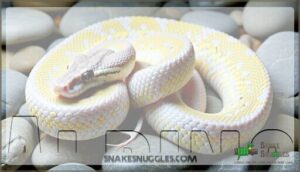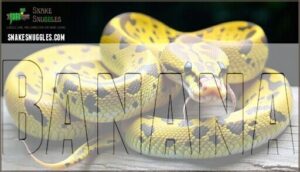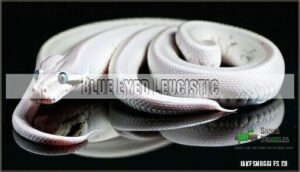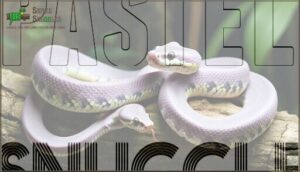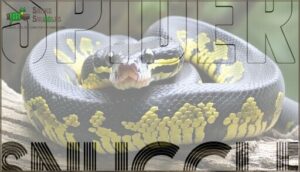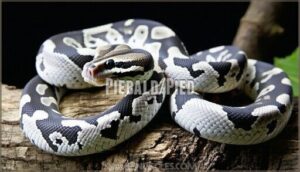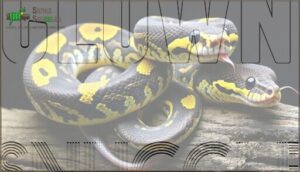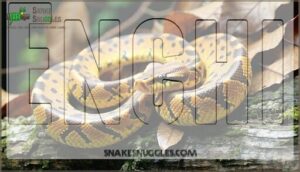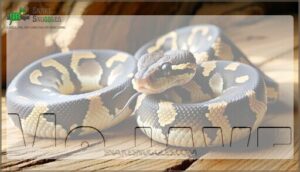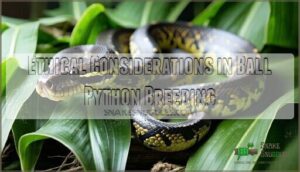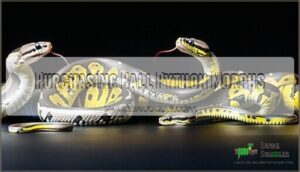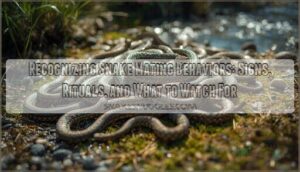This site is supported by our readers. We may earn a commission, at no cost to you, if you purchase through links.

Through selective breeding, you can find morphs like Albino, Banana, or Piebald, each with unique traits—think of them as nature’s living artwork.
Some morphs, like Blue Eyed Leucistics, are pure white with striking blue eyes, while others, like Clown morphs, showcase bold, intricate patterns.
With thousands of morphs available, there’s something for every reptile enthusiast.
But remember, breeding certain morphs, like Spiders, can lead to genetic issues, so it’s worth researching before buying.
Ready to explore ball python morphs?
Table Of Contents
- Key Takeaways
- What Are Ball Python Morphs?
- Popular Ball Python Morphs
- Rare and Exotic Ball Python Morphs
- Ethical Considerations in Ball Python Breeding
- Purchasing Ball Python Morphs
- Frequently Asked Questions (FAQs)
- When did a ball python become a morph?
- What is the difference between a ball python and a morph?
- How many ball python morphs are there?
- What is a Candy ball python morph?
- What is a Butter ball python morph?
- What color is a ball python morph?
- What is the best ball python morph?
- What’s the rarest ball python morph?
- Is a 75 gallon tank too big for a ball python?
- How many morphs of ball python are there?
- Conclusion
Key Takeaways
- You’ll find over 7,500 ball python morphs, each with unique colors, patterns, and traits created through selective breeding.
- Popular morphs like Albino, Banana, and Blue Eyed Leucistic showcase breathtaking colors and patterns, while rare ones like Stormtrooper are highly sought after.
- Ethical breeding is crucial—avoid morphs with known genetic issues, like Spider morphs, which can cause neurological problems.
- Research breeders carefully to ensure healthy genetics, fair pricing, and responsible practices when buying your ball python morph.
What Are Ball Python Morphs?
You’ve probably seen ball pythons with amazing colors and patterns that don’t exist in the wild – these are called morphs, which are genetic variations created through selective breeding programs.
Ball python morphs turn nature’s canvas into living art, showcasing breathtaking colors and patterns crafted through selective breeding.
Ball python morphs display unique combinations of colors, patterns, and physical traits that breeders have developed over decades, with nearly 7,500 different variations available today.
Genetic Variations in Ball Pythons
Ball python genetics reveal nature’s incredible artistry through naturally occurring genetic mutations. These color morphs emerge from complex interactions between recessive genes and dominant genes, creating stunning visual diversity.
Ball python genetics operate through several key mechanisms:
- Allele Expression determines which traits appear visually
- Homozygous Traits occur when identical genes pair together
- Co-Dominance blends characteristics from both parents
- Recessive Genes require two copies to express fully
- Dominant Genes need only one copy to show their effects
This genetic foundation creates thousands of possible combinations.
Created Through Selective Breeding
The magic behind ball python morphs happens through selective breeding.
You’re witnessing decades of careful genetic work where breeders combine recessive traits, dominant genes, and co-dominance to create designer morphs.
This process transforms wild genetics into stunning designer ball pythons.
| Breeding Type | Result | Timeline |
|---|---|---|
| Simple Cross | Basic morphs | 1-2 years |
| Complex Combo | Morph combinations | 3-5 years |
| Multi-gene | Rare designer ball pythons | 5+ years |
Ball python genetics make endless possibilities through strategic breeding.
Unique Patterns, Colors, and Traits
Beyond ordinary snake coloration, ball python morphs showcase extraordinary visual appeal through distinct color mutations and pattern inheritance. These vibrant colors result from specific trait combinations that create stunning variations.
Morph identification relies on recognizing these key features:
- Unique patterns like webbed Spider markings or puzzle-piece GHI designs
- Enhanced color patterns from bright yellows to deep purples
- Distinctive snake colors including pure whites and rich caramels
- Bold contrasts that make each morph unmistakable
These variations occur because of differences in genetics.
Thousands of Different Morphs Exist
Genetic combinations have created an incredible ball python morphs universe.
You’re looking at nearly 7,500 documented variations today, with new morphs appearing regularly through selective breeding.
Pattern diversity ranges from subtle color shifts to dramatic transformations.
Morph classification helps organize this vast python morphs guide, though morph identification can challenge even experts.
This ball python morph list keeps expanding as breeders discover fresh python morphs through innovative genetic combinations.
Popular Ball Python Morphs
You’ll find several ball python morphs that dominate the reptile market due to their striking appearance and reliable genetics.
These popular varieties include the vibrant yellow Albino, the creamy Banana, the pure white Blue Eyed Leucistic, the enhanced Pastel, and the distinctively patterned Spider morph.
Albino
Among the most recognizable morphs, the albino ball python displays striking amelanistic traits that make collectors swoon.
These snakes showcase complete T albinism, where amelanism impact creates their signature look.
You’ll spot these beauties by their:
- Bright yellow and white coloration
- Pink or red eyes that seem to glow
- Complete absence of dark pigments
- Light sensitivity requiring careful albino care
- Higher market value due to breeding albinos complexity
Albino genetics follow simple recessive inheritance, meaning both parents must carry the gene.
Selective breeding can isolate desired genetic traits.
These albino variations represent one of the hobby’s foundational morphs, with a focus on breeding albinos and their unique characteristics.
Banana
The banana morph showcases stunning yellow hues with pink undertones and distinctive freckled patterns.
First clutch appeared in 2003, making banana ball python genetics highly valued.
This banana morph creates beautiful banana pied and banana lesser combinations.
| Feature | Description | Appeal |
|---|---|---|
| Colors | Bright yellow with pink | Eye-catching beauty |
| Patterns | Random banana-like spots | Unique individuality |
| Genetics | Co-dominant mutation | Breeding versatility |
| Pricing | Premium market value | Investment potential |
Blue Eyed Leucistic
Picture holding a living masterpiece – that’s what you’ll experience with Blue Eyed Leucistic (BEL) ball python morphs. These stunning white snakes showcase brilliant blue eyes that’ll make you do a double-take.
BEL genetics create unique breeding challenges, but the results are worth it:
- Pure white coloration with occasional cream tones
- Striking blue eyes that catch light beautifully
- Premium BEL cost reflects their rarity
- Specific care requirements for leucistic snakes
- High collector demand for these morphs
Pastel
You’ll often find pastel ball pythons among the most beloved morphs in the hobby.
The pastel gene brightens yellow pigmentation while reducing dark patterns, creating stunning visual appeal.
Pastel combinations with other morphs produce incredible results, while super pastel specimens showcase intensified colors.
Pastel variations range widely in pastel intensity, making them perfect starter morphs with reasonable pastel price points.
Spider
Spider ball pythons showcase stunning web-like patterns that make them incredibly popular among collectors.
However, the spider gene brings serious concerns about neurological issues and wobble severity.
Many breeders now consider spider alternatives like bumblebee spider combinations.
Spider genetics create beautiful morphs, but breeding ethics questions arise due to potential health problems.
Understanding morph popularity versus animal welfare helps you make informed decisions.
Rare and Exotic Ball Python Morphs
You’ll find that rare and exotic ball python morphs represent some of the most striking genetic variations in the reptile world, often commanding thousands of dollars due to their scarcity and unique breeding challenges.
These extraordinary snakes showcase dramatic color combinations and patterns that don’t exist in wild populations, making them highly sought-after by collectors who appreciate their one-of-a-kind appearance.
Piebald/Pied
The piebald ball python creates a stunning canvas of white patches against dark coloration.
You’ll notice piebald genetics follow recessive inheritance patterns, making het pied breeding essential for producing these beauties.
Head coloration typically remains normal while bodies showcase dramatic pattern variations.
Breeding challenges include:
- Recessive gene requirements for expression
- Albino pied combinations create complex genetics
- Panda pied variants demand careful selection
- Future morphs rely on understanding inheritance patterns
Clown
The Clown ball python displays striking patterns that resemble a jester’s colorful costume.
This recessive mutation creates bold yellow and brown markings against lighter backgrounds.
The clown gene’s unique appearance commands premium prices, making these snakes highly valued collectors’ pieces.
The clown genetics produce stunning combos like the bumblebee clown when bred with other morphs, with fascinating breeding potential.
Enchi
Enchi ball pythons stand out with their vibrant orange-yellow patterns and intricate brown spotting, making them a favorite among python morphs.
Their Enchi gene enhances colors when combined with other morphs, creating dazzling Enchi variations.
- Unique lateral bands with warm tones
- Striking Enchi combinations in breeding projects
- Easily identifiable patterns for Enchi identification
- Affordable price range, appealing to collectors
Mojave
The Mojave ball python morph stands out with its rich caramel tones and unique keyhole markings.
Known for its versatility in breeding Mojave complexes, this morph enhances visual variations like Blue-Eyed Leucistics.
With the Mojave gene, you can create stunning python morphs.
Keep them cozy—90°F on the warm side, 80°F cool—with a reliable heat pad or bulb.
Axanthic
Axanthic ball pythons, with their grayscale beauty, stand out among ball python morphs.
Their lack of yellow pigment results from a recessive mutation, making them a favorite for Axanthic breeding.
Proper care guarantees their health:
- Axanthic care: Warm side at 90-95°F.
- Feed prey matching body thickness.
- Offer ample hiding spots.
Axanthic price varies with genetic variation.
Ethical Considerations in Ball Python Breeding
When breeding ball pythons, you’ve got to think beyond just the colors and patterns.
Ethical breeding means considering the health, well-being, and genetic integrity of the animals to avoid issues like disorders or poor quality of life, which is crucial for their overall well-being.
Spider Ball Pythons and Wobble Syndrome
Spider ball pythons, loved for their web-like patterns, carry the spider gene linked to “the wobble,” a neurological issue causing unsteady movements.
Wobble severity varies, with some snakes showing mild behavioral changes while others struggle substantially.
The genetic predisposition raises questions about breeding ethics. Responsible ownership means understanding these neurological impacts and considering the welfare of these enchanting yet controversial morphs before purchasing or breeding.
Breeding Animals With Genetic Disorders
Breeding ball pythons with genetic disorders raises serious ethical concerns.
You’ve got to prioritize their health and quality of life over flashy looks.
Disorders like the wobble in spider morphs or deformities from inbreeding can severely impact a morph’s lifespan.
- Avoid breeding known defects
- Focus on healthy genetics
- Reject harmful trends
- Promote ethical breeding standards
- Ensure responsible practices
Remember, it’s about responsibility, not just creating eye-catching morphs.
Multi-gene Morph Combinations
Combining genes to create complex morphs or designer morphs in ball pythons produces striking visual outcomes, like bold colors and intricate patterns.
While exciting, improper breeding strategies can lead to severe health issues in some snake morph combinations.
Ethical breeders focus on healthy morph combinations, avoiding risky super forms that compromise welfare.
Always research python morphs before supporting breeding practices.
Axanthic Ball Pythons and Stark Contrasts
When exploring ball python morphs, the grayscale beauty of an axanthic ball python stands out.
These high-contrast color morphs lack red and yellow pigments, creating striking pattern variations. Breeding axanthics requires careful planning to avoid health issues.
One key characteristic is their lack of yellow pigment.
Here’s what you should know:
- Axanthic Genetics: They enhance contrast intensity when paired with vibrant morphs.
- Care Requirements: Proper enclosures and vet care guarantee healthy, thriving snakes.
- Ethical Breeding Axanthics: Avoid pairing with spider morphs to reduce risks of neurological problems.
Choose breeders prioritizing animal welfare.
Purchasing Ball Python Morphs
When you’re ready to purchase a ball python morph, understanding genetics and market trends is key to making a smart choice.
Take your time to research reputable breeders and select a snake that fits both your preferences and budget.
Understanding Genetics and Market Pricing
Understanding morph inheritance and pricing factors is key when exploring ball python morphs.
Genetics, like recessive genes or dominant traits, drive morph pricing and market trends.
Rare genetic mutations, such as Axanthic’s grayscale beauty, often fetch higher prices.
Breeding costs also influence value, with multi-gene combinations requiring more effort.
A Mojave’s caramel hues might cost $250-$400, while Clown morphs, known for bold patterns, can hit $600.
Knowing these details guarantees smart, informed choices.
Many morphs, including normal phase, are available for purchase at varying prices, which is crucial for making informed choices about ball python morphs.
Researching Before Making a Purchase
Buying ball python morphs? Do your homework! Research morph origins and snake genetics to avoid surprises. Understanding morph trait inheritance is essential for responsible breeding.
Check the breeder’s reputation and ask about their care practices. Look for vendors offering:
- Health checks ensuring the snake’s well-being.
- Genetic verification to confirm morph identification.
- Transparent pricing analysis for fair snake morph prices.
A little prep saves headaches—and your wallet!
Choosing From a Range of Patterns and Colors
Choosing ball python morphs is like picking art—you’ve got endless options! From the creamy Albino to the striking Banana, colors and patterns define their charm.
Here’s a quick guide:
| Color Genetics | Pattern Variety |
|---|---|
| Albino ball python | Pied |
| Banana | Clown |
| Blue Eyed Leucistic | Enchi |
| Pastel ball python | Spider |
Understanding ball python morph market trends is essential for making informed decisions. Find your perfect match!
Acquiring Rare and Exotic Ball Pythons
Snagging rare python morphs can feel like finding treasure.
Whether you’re browsing Morph Market or exploring breeder networks, rare morphs like lavender albino pythons or ball python morph combos await.
Look for breeders offering:
- Exotic prices for unique traits.
- Snake auctions with one-of-a-kind options.
- Healthy guarantees from ethical sources.
Expensive ball pythons are worth it for their stunning genetics!
Reputable breeders often specialize in Ball Python Morphs to produce unique specimens.
Frequently Asked Questions (FAQs)
When did a ball python become a morph?
They say necessity is the mother of invention, and in 1992, ball pythons officially became morphs when Bob Clark bred the first Albino.
This breakthrough opened up endless possibilities for vibrant patterns and unique traits.
What is the difference between a ball python and a morph?
A ball python is the original, wild-type species, while a morph is a selectively bred variation with unique colors or patterns.
Morphs are like nature’s artwork, showing off genetic surprises through careful breeding, which can be considered as nature’s artwork.
How many ball python morphs are there?
It’s almost mind-boggling, but over 7,500 unique ball python morphs exist today.
Breeders have worked tirelessly to create stunning patterns and colors, making these snakes a true marvel of genetic artistry and natural beauty.
What is a Candy ball python morph?
A Candy ball python morph has a unique caramel-like coloration with soft yellows and oranges, resulting from a recessive gene.
It’s visually stunning and popular among collectors for its striking, warm-toned patterns, with unique being a key aspect of its appeal.
What is a Butter ball python morph?
With over 7,500 ball python morphs known, the Butter morph stands out for its rich golden tones and sleek caramel undertones.
You’ll love its subtle yet vibrant colors, making it a breeding favorite.
What color is a ball python morph?
A morph’s color depends on its genetics, ranging from creamy yellows to deep blacks or pure whites.
Some even mix vibrant patterns with unique hues, making each one look like nature’s own little masterpiece.
What is the best ball python morph?
The "best" morph depends on your taste.
If you love striking contrasts, Piebald’s white patches might wow you.
Prefer rare and unique? The Stormtrooper morph’s unpredictable patterns could be your dream snake.
What’s the rarest ball python morph?
The Stormtrooper morph is the rarest.
Its unique black-and-white pattern appeared accidentally in 2015 and hasn’t been reproducible since.
If you spot one, it’s like finding a unicorn in the snake world!
Is a 75 gallon tank too big for a ball python?
A 75-gallon tank isn’t too big, but it might feel overwhelming for a ball python.
Add plenty of hides, branches, and clutter to create cozy spaces.
They thrive better in secure, smaller-feeling environments.
How many morphs of ball python are there?
Imagine a kaleidoscope of endless colors and patterns—ball python morphs are just as mesmerizing.
Today, there are nearly 7,500 unique morphs, each a reflection of creativity and genetics in reptile breeding.
Conclusion
Did you know there are over 7,500 ball python morphs identified today?
These incredible genetic variations let you explore endless colors, patterns, and traits, making each snake truly unique.
Whether you’re drawn to the bright yellows of the Banana morph or the sleek, white elegance of Blue Eyed Leucistics, there’s a ball python morph for everyone.
Just remember, research is key—understanding genetics makes it possible for you to choose responsibly and ethically.
Explore and discover your perfect ball python morph!
- https://www.researchgate.net/publication/339918500_Searching_for_snakes_ball_python_hunting_in_southern_Togo_West_Africa
- https://www.9news.com.au/world/snake-with-smiley-faces/d121de50-5fa5-4d98-8839-c5d59e35dcb9
- http://basicgenetics.ansci.cornell.edu/lethal_alleles.php?section=mratios
- http://www.worldofballpythons.com/morphs?q=daddy
- https://www.xyzreptiles.com/reptiles/animals/snakes-for-sale/ball-pythons-for-sale/

